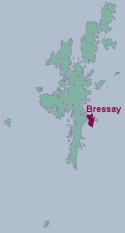Bressay

| OS Name: | Bressay |
|---|---|
| Shetland Name: | Bressay |
 | |
| UK Grid Reference: | Ordnance Survey |
| Area (ha): | 2805 ha |
| Population: | 400 approx. |
| Community Council: | Bressay |
| Ferry Services: | Leirna Ro-Ro service from Lerwick |
| Notes: |
Bressay (From Old Norse Breiðey or Brús(a)ey meaning either 'Broad Island' or 'Brusi's Island'), is an island with a population of around 400 people, the main density of population being on its west coast. The island is separated from Mainland Shetland, by Bressay Sound, on the west side of which lies Lerwick, the capital of Shetland.
Bressay Sound, with its north entrance, Da Nort Mooth, and its south entrance, Da Sooth Mooth, forms Lerwick Harbour.
Bressay is served by a ro-ro ferry between Lerwick and Maryfield. Plans have been formulated for a bridge to replace the ferry, but opposition to the plan by the Lerwick Port Authority, which would prefer a tunnel, has meant that the fixed link has become bogged down in political debate.
Bressay's highest point, the Ward of Bressay, (226m), has an antenna array which carries the transmitter antenna for the TV and public broadcast radio services for Shetland, as well as mobile phone, and other communication systems. Another high point is Ander Hill, (145m), on the east side, with an old coastguard watch tower.
During the Hanseatic times there were several references to Hanseatic settlements at Brusa Sound, Brassa Sund or similar. A Dutch map from the 17th century, (a copy now kept in the Maritime Museum at Bremerhaven), shows the placename Arentsburgh on the north coast of Bressay. One reason for that name may be that it was a name used by Danish fishermen, (the then (German) Earls of Rantzau were nobilities to the Danish Crown, (Chancellors of Denmark etc.), and had their residence at Ahrensburg, a castle and town near Hamburg/Germany.
Other old maps have "Arentsburgh" at a different location, on the south end of Bressay where the rock "Stoura Klett" is located, and with a different explanation of the name.
Attractions on the island include Bressay Heritage Centre and the old laird's mansion Gardie House, built in 1724, Bressay Lighthouse built in 1858 by Thomas and David Stevenson, sea caves and arches, and gun emplacements dating from World War I (Aith Ness and the Bard) and World War II (Cruister) to guard ships in Bressay Sound. The guns on Bard Head, at the tip of the Bard were serviced from barges floating below, ammunition was landed using the derrick still visible on the cliff top.
Bressay is home to the poet and author Stella Sutherland and Dr. Jonathan Wills, a politician and author who has written a brief guide to the isle among other topics.
During the summer months, there is a passenger ferry service across the narrow Noss Sound that links the east coast of Bressay to Gungstie on the uninhabited island of Noss which is a National Nature Reserve.
